The benefits of avocado for weight loss
This fruit is useful for normalizing weight, if only because it contains many nutrients that normalize metabolic processes in the body (excess weight is often a consequence of disruption of these processes).
100 grams of avocado contain (% of the daily value):
- Vitamin K: 26%
- Folic acid (folates): 20%
- Vitamin C: 17%
- Potassium: 14%
- Vitamin E: 10%
It also contains niacin (Vitamin B3), riboflavin, copper, magnesium, manganese and antioxidants, a lot of fiber and few carbohydrates (in this case only 9 g, of which 7 g are from dietary fiber).
Avocado: so tasty, but so high in calories!

The calorie content of an alligator pear (another name for an avocado) has long frightened those who want to lose weight. After all, the fresh fruit has the highest fat content among all fruits. And today many people have a prejudiced attitude towards him. What is this product and should it be avoided?
The homeland of avocados is South America. It is grown in Mexico and all countries of Southern Europe. The fruit (which for some reason many consider to be a vegetable) looks very peculiar: on top it is covered with a smooth or wrinkled green peel. This fruit tastes oily, somewhat reminiscent of a pear.
There is no escaping the truth: avocados are high in calories. But this in no way interferes with the benefits of the exotic fruit and does not reduce its dietary abilities. The secret is that it contains monounsaturated fats. They are completely processed, protect the heart from disease, and the body from inflammation. Therefore, avocado is an element of a healthy diet.
Avocado calories

Unlike most fruits, avocados are high in fat—about 15% of their total weight—with 77% of their calories coming from these fats.
How many calories are in one avocado?
Of course, the exact number of calories will depend on the size of the fetus. If you take a certain average size (201 grams), then it will contain 322 calories. The fruit will have 30 g of fat, of which 4.2 g are saturated, about 20 g of monounsaturated, 3.6 g of polyunsaturated fat, as well as 13.5 g of fiber.
True, knowing how many calories are in 1 piece. Avocado is not always healthy, because... We rarely eat the whole fruit.
Calorie content of avocado per 100 grams
From the above we can conclude that there will be approximately 160 calories per 100 g. Is this too much? Well, for example, 100 g of strawberries contains 32 calories. That is, if you strictly monitor calories, then perhaps you should take this point into account.
Calories per tablespoon
Measuring in tablespoons is also a convenient option, especially if you like to spread the fruit pulp on bread or toast.
So, 1 tbsp. will be equal to approximately 15 g of pulp, and contain approximately 25 calories.
2 tablespoons equals approximately 1/5 of a whole medium-sized fruit.
How to get a flat stomach with avocados?
Considering how high the calorie content of avocados is, it becomes clear that there are no mono-diets on this product. It only participates in the process of weight loss. To do this, you should remove all desserts and fatty dishes from your diet, and instead include ¼ or even 1/5 of a ripe avocado in the menu. It can be consumed as an independent dish or as part of others (light salads, which include lettuce, cucumber, chilled rice).
Almost everyone can eat avocados. It is not suitable only for those who have an individual intolerance or allergic reactions to latex.
As a result of numerous studies, it has been found that people who do not count how many calories are in this fruit, but regularly eat avocado, have a lower body mass index and excellent health, so consuming it will benefit both their figure and their body.
Healthy fats
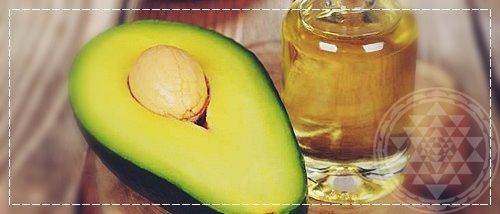
Most of the fats in avocados are monounsaturated, with only a small portion being saturated and polyunsaturated fats.
The main amount of monounsaturated fat is oleic acid, the same acid found in olives and olive oil. This is a very healthy type of fat.
Numerous studies show that oleic acid can reduce inflammation and reduce the risk of heart disease.
How many calories are in one avocado (calorie content of 1 avocado or per 100 grams)
Avocado contains a large percentage of fat in relation to protein (16%) and carbohydrates (17%) - fat contains 67%. Therefore, avocado is the record holder among fruits in terms of calorie content - 100 g of the product contains 160 kcal.
Few have tried the exotic avocado. But the calorie content and nutritional value (how many calories are in 100 g - read in our article) of this fruit allow you to get enough and enrich your body with a lot of useful substances, without gaining extra pounds
The average weight of one avocado without pits and skin is 180 g, therefore, the calorie content of the product is 290 kcal.
Despite such a high calorie content, avocado fats are very well absorbed by the body; a person does not gain weight from eating the fruit , but on the contrary, may even lose weight. That’s why avocado diets are so popular among women, which can be done once a month for 3 days.
It should be noted that this tropical fruit has many vitamins. Vitamin A helps maintain vision; B vitamins – strengthen the nervous system; vitamin C and other important vitamins are necessary for the body.
In addition, it contains various microelements, for example, selenium and iron necessary for the body, which our earth is often poor in, and hence its fruits. Iron is especially necessary for people suffering from anemia.
Avocado is recommended for consumption by people suffering from anemia
Regular consumption of avocados reduces the risk of developing cardiovascular diseases, stroke, gastrointestinal diseases, vision problems and others.
However, in addition to benefits, this fruit can also cause harm. Avocado is strictly contraindicated for people suffering from food allergies , as it can provoke an allergic reaction.
Overeating avocado can lead to disruption of the stomach and intestines, increased flatulence, diarrhea or constipation.
As already noted, avocado, even with a high calorie content, is recommended for weight loss, as it contains easily digestible fats that are not deposited in the body.
When consuming this fruit, you should limit yourself to sweets and starchy foods, lead an active lifestyle, and do exercises in the morning.
There are quite a few recipes with avocado; you can use it to make delicious salads, pate, smoothies and other dishes.
Please note: avocado does not have a strong and specific taste, it is almost tasteless, so it is suitable for consumption with fish and other seafood.
The nutritional value (how many calories) of the subtropical fruit, as we have already found out, is quite high. Therefore, salads with fruits and vegetables that are low in calories are most often prepared with avocados.
An example of such a salad is a recipe with tomatoes, sweet (bell) peppers, onions and cucumbers in equal quantities. Mix everything and add any vegetable oil to taste. The salad has about 100 kcal.
Diet salad for weight loss with shrimp and avocado (calorie content of salad – 110 kcal)
- 1 tbsp. l. vegetable oil;
- 1 tbsp. l. cilantro, coriander;
- 2 tbsp. l. lime juice;
- 500 g shrimp:
- 200 g cherry tomatoes;
- 1 avocado;
- salt – 1 tsp;
- ground black pepper - to taste.
- Wash the fruit, cut it, remove the pit, remove the skin and cut into thin slices.
- Finely chop the washed cilantro.
- In a salad bowl, whisk together vegetable oil, cilantro and lime juice.
- Add cooked shrimp, cherry tomato slices and avocado slices to the mixture.
- Mix everything carefully and serve immediately.
This salad should be consumed immediately.
This salad is not only tasty, but also beautiful:
- Wash the avocado well, cut it and remove the pit.
- Use a spoon to remove the pulp from the fruit and mash it or cut it into pieces.
- Boil the rice.
- Boil 5 shrimp.
- Mix boiled rice (50 g), shrimp and fruit pulp and place in the middle of the fruit.
100 g of this dish has 185 kcal.
You can make pate from avocado for breakfast.
For 4 people, it is enough to take 1 piece of avocado. Wash, remove pits and skin, mash to puree. If desired, you can add ketchup, pepper, salt, garlic, 2 tsp. lemon juice and season everything with sunflower oil.
Place the mixture on a dried loaf. Eat immediately.
Nutritional value (i.e. how many calories) 100 g of pate is about 225 kcal.
- smoked fish – 1 piece;
- avocado – 1 piece;
- homemade cream – 100g;
- soft cheese – 100g;
- garlic – 5-7 cloves;
- sesame;
- add greens and herbs if desired.
- Clean the fish and grind in a blender.
- Wash, peel, remove the pit and grind the avocado to a puree.
- Mix the resulting mixture with cream, cheese, crushed garlic, sesame seeds and finely chopped herbs.
- Add pepper and salt.
Place the resulting pate on bread, toast or a soft loaf. The calorie content of such a sandwich is about 230 kcal.
For those who want to lose weight, you can prepare a low-calorie sandwich with avocado pate (50 kcal per 100 g). To do this, mash the avocado pulp, add 1 tomato without skin. Season with herbs and spices to taste. Spread on soft or toasted bread.
In Italy, the most popular product is pasta, which is called pasta there, regardless of its shape and size. The nutritional value (how many calories are in 100 g of product) of pasta, by the way, is also high.
The cooking time is always written on the packages; you need to know it and remove it from the heat 1-2 minutes earlier. For variety, all kinds of seasonings and sauces are added to these products, which make ordinary pasta incredibly tasty.
Often fruits are used for this, in particular avocados. Various sauces are usually prepared from it.
The easiest one to prepare is a cream sauce. It requires:
- 1 ripe avocado (pulp);
- yogurt without additives or heavy cream – 100 g;
- vegetable oil – 50 ml;
- garlic – 3 cloves;
- lemon juice – 1 tbsp. l.;
- to taste and desire - salt and pepper.
Mix all the above ingredients until pureed.
The cooked pasta is mixed with the prepared cream sauce. To improve the taste of this dish, you can add 10 g of nuts, 10 g of raisins and some chili pepper (dried). This dish has a calorie content of 165 kcal per 100 g.
Cream is known to be a high-calorie product, so those who want to lose weight can prepare a cream-flavored pasta sauce. To do this you will need:
- avocado – 2 pcs.;
- finely chopped 1 clove of garlic;
- finely chopped 1 shallot;
- juice from one lemon;
- olive oil – 50 ml;
- finely chopped parsley - 0.5 cups;
- salt and pepper - to taste;
- 400 g spaghetti or other pasta.
- Cook pasta (pasta) until al dente.
- Prepare the sauce.
- Drain the water from the finished pasta, leaving 100 g of broth.
- Place the pasta on a dish and mix with the sauce, add pasta broth if necessary.
- Sprinkle the top of the pasta with parsley or other herbs as desired.
100 g of prepared such a dish contains about 150 kcal.
Eggs Benedict is a very popular breakfast all over the world, where the base is bread. But you can use avocado instead of bread. For this sandwich, a poached egg is placed between thin slices of avocado.
This breakfast is low in calories. Nutritional value - only 70 kcal per 100 g.
A poached egg cooks very quickly. To do this, an egg without a shell is thrown into hot water, but so as not to boil, and after 2 minutes it is removed.
For 4 servings take 2 ripe avocados, 4 pcs. eggs; chopped green onions - 2 tbsp. l.; salt to taste; pepper optional.
- The avocado fruit is cut, the pit is removed, and the pulp is taken out so that a whole egg can fit inside.
- An egg is beaten into the fruit halves, salted and sprinkled with spices.
- Place the halves of the fruit tightly together in a deep frying pan or baking dish. Place in the oven, heated to 210 degrees for 20 minutes.
- The finished dish is sprinkled with green onions.
Smoothies first appeared in America in 1920. This is a dietary cocktail, quite filling, but low in calories. The consistency is thicker than yogurt.
The drink is prepared from mixtures of berries, vegetables, fruits with the addition of herbs, seeds, nuts, oatmeal, green tea and dairy products (kefir, plain yogurt, cottage cheese, etc.).
Fans of exotic fruits prefer smoothies made from avocado and bananas. To do this, put in the blender:
- 2 washed, peeled and finely chopped avocados (the fruit should be ripe, if when you press on the fruit it is soft, then this is what you need);
- 1 washed, peeled and finely chopped banana;
- oatmeal – 2 tbsp. l.;
- honey – 1 tsp;
- a pinch of cinnamon.
Pour 150 g of milk over all this. Beat at maximum speed for 0.5 minutes. Calorie content – 128 kcal per 100 g.
According to the American Doctor Oz, avocado and orange are an excellent combination for weight loss. Orange reduces stress hormone levels, and avocado has unsaturated fats. According to the American, a smoothie made from these fruits is especially suitable for those who want to lose weight.
To do this, in a blender you need to mix and beat: 1 avocado, juice from 2 oranges, 1 medium carrot, 100 g of water and milk, if desired, you can add honey for taste.
Avocado is a fruit that Russians knew nothing about until recently. But today it is already known that this southern fruit, which has a low calorie content but good nutritional value, improves health due to its saturation with vitamins and minerals.
Unsaturated fats are almost completely absorbed by the body and satisfy hunger. Therefore, they are a good diet for weight loss.
Take care of yourself and be healthy!
Don't miss the most popular articles in the section:
We invite you to watch an interesting video about avocado (calorie content and nutritional value of the fruit, how many calories are in one fruit, its benefits and harm):
How to make a healthy breakfast with avocado - see recipes for low-calorie toast, but with high nutritional value:
Martini. How to drink a cocktail Bianco, Asti, Rosso. Price 1 liter, home recipe
lubovnaya.ru
Fats and fiber for weight loss
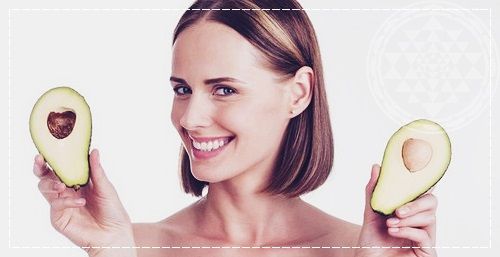
Foods rich in fats or dietary fiber make you feel full after eating. This is because they slow down the movement of food from the stomach to the intestines, which makes us feel full longer, snack less between meals, and therefore consume fewer extra calories per day.
Avocados happen to be high in both fat and fiber, so they keep you full for a long time.
There is even a study on this topic (2), which says that if a person eats half a fruit for lunch, he does not feel like eating for the next almost 5 hours (the effect is stronger in the first 3 hours, then gradually fades away).
Participants felt 23% more full after eating a meal that included avocados compared to those without the fruit.
Benefits for the human body
The benefits of avocado for the human body are determined by the harmonious combination of vitamins, minerals and healthy fatty acids it contains.
Let's look at this issue in more detail:
- The positive effect of this product on the heart is due to the large amount of potassium, magnesium and some other nutrients important for the cardiovascular system. Doctors recommend eating avocados to prevent stroke and atherosclerosis.
- For people with low hemoglobin, this fruit should also become a regular part of the diet. The amount of iron fully corresponds to the daily requirement that a person needs.
- Relieves problems of the digestive system and constipation.
- Oleic acid, which is part of the fruit, helps break down cholesterol and prevents its formation.
- Vitamin B6 normalizes liver function.
- Avocado is no less useful for the eyes, as it helps maintain visual acuity. Doctors recommend consuming the fruit to prevent cataracts.
- Vitamin E has a beneficial effect on the skin and hair: it is used in masks for the face and hair.
- For people with diabetes, avocado is one of the must-have foods. 30 g of fruit contains only 3 g of carbohydrates and no more than 1 g of glucose, so people with diabetes do not have to worry about a sharp jump in sugar. Avocados also contain a lot of fiber and fats, they are well absorbed, but are digested slowly, which also regulates blood sugar levels.
Important! All the beneficial properties that avocados have are preserved only in the raw product. After heat treatment of the fruits, practically nothing useful will remain in them. You can eat avocados in dried form: in this product some of the nutrients are retained.
Avocado oil is also useful, but more for cosmetic purposes: it is used to prepare masks, creams, shampoos and other care products. It is also added to massage oil and used in aromatherapy. This product prevents the appearance of wrinkles and age spots. Avocado oil moisturizes and nourishes the skin of the face and body. This product gives strength to hair and nails.
But the avocado pit and peel are harmful to human health. They contain substances such as persin and tannin, which lead to upset of the digestive system, and in some situations can provoke an allergic reaction. Therefore, you should not eat the kernels of this fruit, especially since they taste bitter.
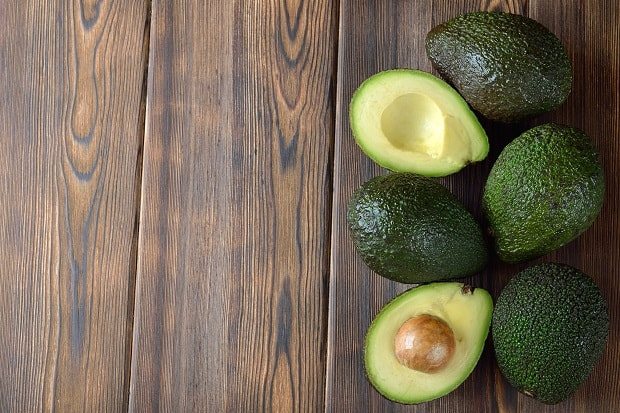
© olyina – stock.adobe.com
For women, avocado is beneficial not only as a component of cosmetics. Some doctors believe that this product should be consumed as a preventive measure for breast cancer.
Men should also not give up avocado, because it has a positive effect on potency: it increases libido, acting as a natural aphrodisiac. This wonderful product also serves as a preventative against prostate cancer.
How many avocados do you eat a day to get enough nutrients? The dose recommended by doctors is 100 g per day. As for exactly how to consume this fruit, it all depends on personal preference. You can eat it as a snack, or as a side dish for meat or fish.
For people practicing dietary nutrition and a healthy lifestyle, avocado is an indispensable product.
Support normal weight

Scientists have generally noticed an interesting relationship: people who eat more vegetables and fruits usually have lower body weight and are closer to normal.
And there is scientific evidence that avocados also help keep your weight in check. (3)
And although there is not yet enough scientific data to definitively say that avocados directly help you lose excess weight, this fruit does have properties that help you lose weight:
- Avocado fat burns faster than other types of fat.
- It can speed up the burning of other fats.
- It increases calorie expenditure after eating.
- It reduces appetite and the desire to snack between meals.
However, it is important to remember that these weight loss properties of avocado will manifest themselves in different people with varying degrees of intensity.
Chemical composition
Avocado has a rich and varied chemical composition that combines many beneficial substances. This, together with its nutritional value, allows the fruit to be used as part of restorative nutrition. Fruits can be included in dietary complexes; they can replace proteins and calcium that enter the body with food of animal origin.
The fruit contains the following macro- and microelements:
- Iron. This component stimulates oxygen metabolism and has a positive effect on the activity of the circulatory system. Prevents the development of anemia, increases hemoglobin in the blood, normalizes metabolic processes, and improves immunity.
- Magnesium. The element increases the strength of nail plates, has a positive effect on hair structure, and restores hormonal balance.
- Fluorine. It takes part in the formation of bone tissue and cellular metabolism. Normalizes brain activity, improves the nervous system, and normalizes metabolism.
- Selenium. Strengthens resistance to disease, normalizes the functioning of the reproductive organs, and restores the circulatory system. This mineral also increases the strength of nail plates, heals the skin, strengthens hair, and reduces the negative effects of free radicals.
- Iodine. The element has a beneficial effect on metabolic processes and promotes the rapid restoration of damaged tissues. Controls the consumption of oxygen by cellular structures, regulates energy, water and fat metabolism.
- Calcium. It has a positive effect on the skin, strengthens bones, and normalizes internal organs and systems.
- Zinc. It is an antioxidant, slows down the aging process, and rejuvenates the cellular structures of the skin.
- Copper. Is a strong antioxidant. Enhances regeneration, promotes rejuvenation, takes part in the formation of collagen, melanin, histamine. It has a beneficial effect on the activity of blood vessels and the heart, improves the functioning of the reproductive organs, normalizes hormonal levels and restores the nervous system.
- Potassium. The component restores hormonal balance and improves emotional levels. It has a strong anti-inflammatory effect, increases skin elasticity, and slows down its aging. Has a beneficial effect on the functioning of the heart and blood vessels.
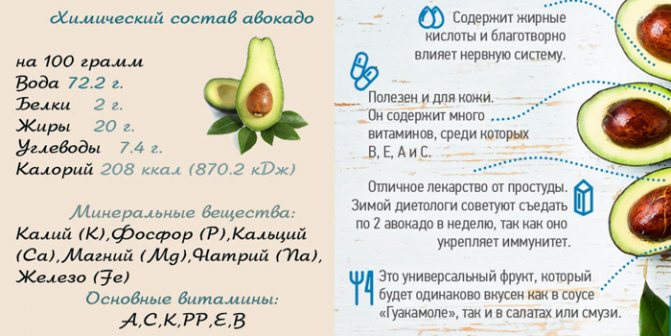
In addition to minerals, avocado contains other useful components:
- Retinol. This substance enhances restoration processes in cellular structures. Regenerates damaged skin, increases the body's resistance, normalizes hormonal levels, and restores the nervous system.
- Thiamine. The vitamin strengthens muscle tissue, normalizes metabolism, participates in the structure of cellular structures, and is part of enzymes.
- Pantothenic acid. The substance improves visual functions, accelerates metabolism, increases the strength of blood vessels, stimulates cell growth, and triggers recovery processes.
- Vitamin E. Provides better absorption of fats and proteins. Normalizes tissue respiration processes, restores the functioning of the brain, circulatory and nervous systems, stimulates the healing of wounds and injuries, and has a rejuvenating effect.
- Vitamin A (retinol). It has a positive effect on the skin and hair, and triggers restoration processes in the body. Its intake has a positive effect on the state of cellular metabolism, causes increased blood circulation, and regenerates damaged cells.
- Vitamin B9. This component is folic acid, it enhances the development of new cellular structures, increases the speed of restoration processes, participates in the synthesis of blood cells (erythrocytes and platelets), has a positive effect on the functioning of the digestive organs, and restores metabolism. Folic acid is required during pregnancy.
- Vitamin B6. Takes part in cellular metabolism, restores the body. Reduces the harmful effects of medications and has a positive effect on the condition of blood vessels. Improves the skin, normalizes the nervous system.
- Vitamin K relieves excessive dry skin, evens out complexion, and increases the body's protective properties.
- Ascorbic acid (vitamin C). This substance strengthens the immune system and enhances protective properties. Makes the walls of blood vessels more elastic, has a positive effect on the nervous and circulatory system. Increases the protective functions of the dermis, making the skin firmer and more elastic.
- Vitamin D. It is required for the normal functioning of the skeletal system. Enhances cell growth, prevents the development of rickets, improves the condition of hair, nails, and teeth. Prevents the development of excessive dry skin, slows down aging.
The uniqueness of avocado fruit
Avocado belongs to the fruit of the laurel family, growing in the tropics and subtropics. The pear-shaped fruit reaches a length of 20-25 cm. The weight of ripe fruit is about 200-350 g. Fruits weighing 100-200 g have the highest nutritional value and calorie content. Avocados without pits and peels are used in cooking, which does not have useful characteristics . The fruits are used in the preparation of cosmetic products (creams, milk, scrubs, oils).
The fruit is rich in healthy ingredients and does not contain harmful sugars and fats, therefore it is used in dietary nutrition.
The fruit contains antioxidants and bioactive substances carotenoids (beta-carotene, zeaxanthin, lutein). When included in a diet, the composition of the product is taken into account: the calorie content of an avocado (in 1 piece) is about 200 kcal. The energy value of avocados is high, but the presence of monounsaturated acids prevents the body from accumulating calories. Avocado is included in the list of dietary products according to the glycemic index.
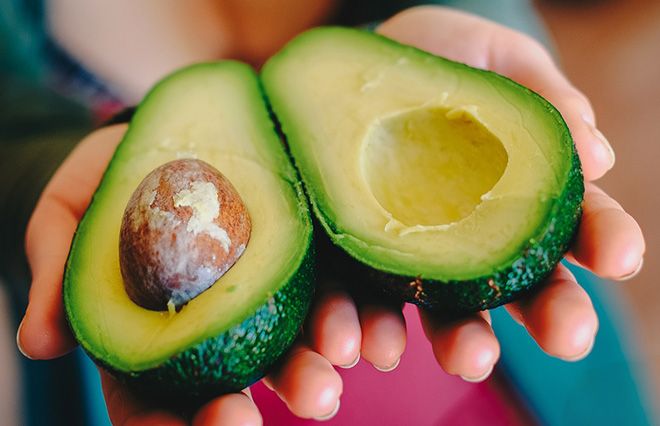
Avocado nutritional value

The tropical fruit has, to put it mildly, specific taste qualities that not everyone liked. But as soon as people learn about the nutritional value of this overseas fruit, it immediately appears in their diet. Avocado pulp is enriched with fats, vitamins, micro- and macroelements.
Component composition:
- riboflavin;
- retinol;
- calcium;
- tocopherol;
- pantothenic acid;
- potassium;
- vitamin B4;
- ascorbic acid;
- folic acid;
- niacin equivalent;
- pyridoxine;
- magnesium;
- phosphorus.
The pulp of the fruit contains potassium in large quantities, which is the main cardiac element. With its help, the vascular walls, the heart muscle are strengthened, and the functioning of the cardiovascular system in general is improved.
On a note! In addition to the above components, avocados are enriched with vitamin K and fiber.
Calorie content of 1 piece avocado

Mexico is considered the birthplace of this culture. The plant is an evergreen tree that belongs to the laurel family. Currently, breeders have developed many varieties of this fruit. In many tropical countries there are extensive plantations where alligator pear is grown. Today it is no longer uncommon and is used in everyday nutrition. The pulp is used to prepare soups, salads, sushi, sandwiches and various snacks. It goes great with seafood. Avocado is a dark green fruit of a tall tree that is common in Mexico, South America and is found in some European countries. The fruit has excellent taste characteristics and is most often used in cooking, medicine and cosmetology.
It is recommended to be used as a substitute for eggs and meat. Therefore, the fruit is an alternative food option for believers during Lent and people who practice vegetarianism.
Benefit
Alligator pear is a source of vitamins such as A, E, C, PP, group of B vitamins. Other important components are iron, phosphorus, calcium and other elements valuable for the body. Avocado has a beneficial effect on the functioning of the cardiovascular system, stomach, intestines, and liver. It helps remove cholesterol from the blood and strengthens the body's defenses. In addition, the fruit contains substances that have a detrimental effect on cancer cells, as well as protein necessary for the formation of muscle tissue. Even people with diabetes can eat it. During heat treatment, the number of useful elements in the product is significantly reduced, so it is more preferable to use it raw.
The fruit contains a large amount of vitamins, minerals and monosaturated fats. It is easily absorbed by the body and reduces the risk of heart disease, diabetes and hypertension.
Contraindications
It is not recommended to eat the fruits for persons who are allergic or intolerant to this product. In addition, you need to remember that you should not consume it in large quantities in order to avoid the occurrence of unwanted reactions of the body. Only the pulp is edible, but the pit contains dangerous substances, so it must be thrown away.
Calorie content and BZHU
The calorie content of avocado depends on the variety, but generally 100 g of product contains 120-167 kcal. Overweight people are advised to take the fruit in small portions.
Nutritional value per 100 grams:
- Calories 167 kcal
- Proteins 2 g
- Fat 15 g
- Carbohydrates 6 g
- Organic acids 0.1 g
- Ash 1 g
- Dietary fiber 0.6 g
- Water 73 g
The average weight of one avocado varies from 180 to 200 g, but there are specimens whose weight can exceed 1.5 kg. Most often on the shelves there are fruits weighing no more than 200 g, calorie content 1 piece. which is approximately 290-300 kcal. Additionally, it is impossible to reduce the calorie content of the product.
During the diet
Avocado is a fairly high-calorie fruit, but when losing weight, you can eat it in small quantities, since it does not contribute to the formation and accumulation of fat. If you follow a strict diet with a lot of restrictions, the rich vitamin composition of the culture will help to saturate it with all the necessary nutrients. There are fasting diets, the main component of which is alligator pear.
It is recommended for use by those losing weight, as well as people who work hard and athletes.







